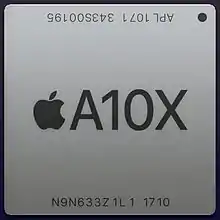Apple A10X
The Apple A10X Fusion is a 64-bit ARM-based system on a chip (SoC) designed by Apple Inc. and manufactured by TSMC. It first appeared in the 10.5" iPad Pro and the second-generation 12.9" iPad Pro, and iPad 6 (2018) which were both announced on June 5, 2017.[6] The A10X is a variant of the A10 and Apple claims that it has 30 percent faster CPU performance and 40 percent faster GPU performance than its predecessor, the A9X.[6]
 | |
| General information | |
|---|---|
| Launched | June 13, 2017 |
| Discontinued | April 20, 2021 |
| Designed by | Apple Inc. |
| Common manufacturer(s) | |
| Product code | APL1071[2] |
| Max. CPU clock rate | to 2.38 GHz[3] |
| Cache | |
| L1 cache | Per core: 64 KB instruction + 64 KB data[4] |
| L2 cache | 8 MB shared[4] |
| Architecture and classification | |
| Application | Mobile |
| Technology node | 10FF nm[1] |
| Microarchitecture | Hurricane and Zephyr |
| Instruction set | ARMv8.1-A: A64, A32, T32 |
| Physical specifications | |
| Cores |
|
| GPU(s) | 12 core[5] |
| Products, models, variants | |
| Variant(s) | |
| History | |
| Predecessor(s) | Apple A9X |
| Successor(s) | Apple A12X Bionic |
Design
The A10X features an Apple-designed 64-bit 2.38 GHz[3] ARMv8-A six-core CPU, with three high-performance Hurricane cores and three energy-efficient Zephyr cores.[5][1] The A10X also integrates a twelve-core graphics processing unit (GPU)[5] which appears to be the same Apple customized Imagination PowerVR cores used in the A10.[7] Embedded in the A10X is the M10 motion coprocessor.[8]
Built on TSMC's 10 nm FinFET process[7] with a die size of 96.4mm2, the A10X is 34% smaller than the A9X and was the smallest iPad SoC upon its release.[1] The A10X is the first TSMC 10nm chip to be used by a consumer device.[1]
The A10X is paired with 4 GB of LPDDR4 memory in the second-generation 12.9" iPad Pro[9] and the 10.5" iPad Pro,[2] and 3 GB in the 4K Apple TV.[10]
The A10X has video codec encoding support for H.264. It has decoding support for HEVC,[11] H.264, MPEG‑4, and Motion JPEG.[12]
Products that include the Apple A10X
See also
- Apple silicon, the series of ARM-based system-on-a-chip (SoC) processors designed by Apple.
- Apple A10 Fusion
References
- Smith, Ryan (June 29, 2017). "TechInsights Confirms Apple's A10X SoC Is TSMC 10nm FF; 96.4mm2 Die Size". AnandTech. Archived from the original on July 2, 2017. Retrieved June 30, 2017.
- "iPad Pro 10.5" Teardown". iFixit. June 13, 2017. Archived from the original on June 17, 2017. Retrieved June 14, 2017.
- Cunningham, Andrew (June 12, 2017). "Review: The 10.5-inch iPad Pro is much more "pro" than what it replaces". Ars Technica. Condé Nast. Archived from the original on June 13, 2017. Retrieved June 12, 2017.
- "iPad7,4". Geekbench Browser. Primate Labs. June 11, 2017. Archived from the original on September 22, 2022. Retrieved June 12, 2017.
- Humrick, Matt (June 6, 2017). "Apple Refreshes iPad Pro Lineup: A10X Fusion SoC for 10.5-inch, 12.9-inch Models". AnandTech. Archived from the original on June 7, 2017. Retrieved June 7, 2017.
- "iPad Pro, in 10.5-inch and 12.9-inch models, introduces the world's most advanced display and breakthrough performance" (Press release). Apple. June 5, 2017. Archived from the original on June 5, 2017. Retrieved June 5, 2017.
- Wei, Andy (June 29, 2017). "10 nm Process Rollout Marching Right Along". TechInsights. Archived from the original on August 3, 2017. Retrieved June 30, 2017.
- "iPad Pro Tech Specs". Apple. June 5, 2017. Archived from the original on June 5, 2017. Retrieved June 5, 2017.
- "10.5-inch and 12.9-inch 2017 iPad Pro FAQ: Everything you need to know!". iMore. Archived from the original on 2016-08-17. Retrieved 2017-06-15.
- "Apple TV 4K Teardown". iFixit. September 25, 2017. Archived from the original on September 26, 2017. Retrieved September 26, 2017.
- Thomson, Gavin. "Introducing HEIF and HEVC". Apple. pp. Slide 71 of presentation. Archived from the original on 27 December 2021. Retrieved 27 December 2021.
- "iPad Pro (10.5-inch) - Technical Specifications". support.apple.com. Retrieved 2022-11-05.